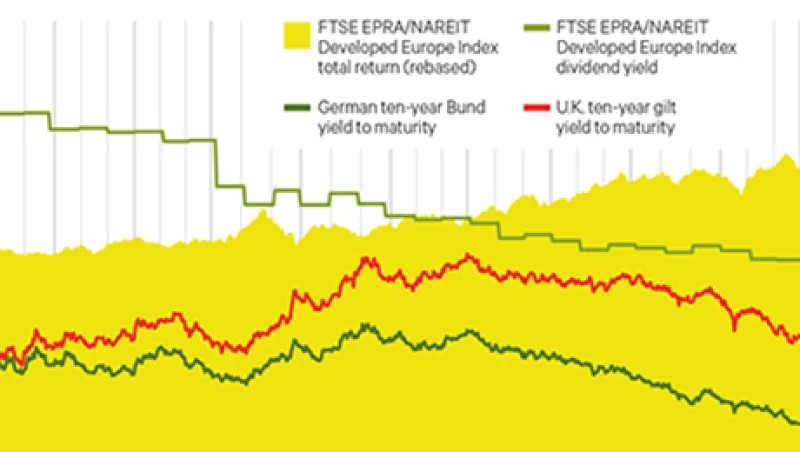Anticipation of quantitative easing in the euro zone has boosted the values of a host of assets, but few more than real estate investment trusts. This year European listed real estate companies, including REITs, have enjoyed a total return of 17 percent through February 13, far outstripping the region’s bonds and general stock indexes. The FTSE EPRA/NAREIT Developed Europe Index rose strongly before the European Central Bank announced its bond-buying program on January 22, and it kept climbing in February. By reducing bond yields, QE pressures investors to buy riskier, higher-yielding assets such as REITs.
The sector’s performance reflects improved economic prospects and the availability of cheap funding, investors say. “At heart, real estate, including REITs, is a procyclical asset class,” says James Wilkinson, London-based European CIO of asset manager BlackRock’s global real estate securities division. “When economies do well, real estate tends to do well.” Interest payments are often the biggest part of REITs’ costs, adds Wilkinson, whose New York–based firm invests about $100 billion in REITs worldwide. “Interest costs have come down very significantly and are continuing to come down,” he says.
Investors are keen to get in on the action. In January, ahead of the ECB announcement, Swiss private bank Julius Baer doubled its recommended exposure to REITS for euro-denominated portfolios to 6 percent. “If you are in the right places and property classes, then fundamentally, yes, it’s a very interesting sector,” says Roger Degen, Geneva-based equity analyst for banks, insurance and real estate at the firm, which manages SFr291 billion ($311 billion) in assets.
But most bright investment ideas are valid only for a limited time. The dividend yield on FTSE EPRA/NAREIT Developed Europe, which includes the U.K., fell from 5.5 percent in May 2012 to 2.8 percent as of January 30. Are REITs still enticing? Yes, according to Didier Duret, Amsterdam-based head of ABN Amro’s Global Investment Advisory Center and CIO of the firm’s €187.5 billion ($213 billion) private banking division. Acknowledging that REITs can be risky, he notes that “at a certain stage it may also be too risky to invest in bonds” because their yields are liable to rise. “That is why we are underweight them,” says Duret. He also believes REITs have become less risky because they’re less indebted.
REITs’ loan-to-value ratios were often as high as 70 percent before the credit crisis, but today they range between 35 and 50 percent for “good-quality names,” Degen of Julius Baer says.
BlackRock’s Wilkinson points out that the underlying real estate market in which European REITs invest doesn’t look overpriced compared with yields on safe government bonds. In many parts of Europe, he says, the sort of properties in which REITs and other institutions invest offers differentials to safe government bonds of 4 percent — above the historical long-term average of 2.5 to 3 percent.
But REIT investors concede that the fall in yields forces them to be much choosier, though they still see strong selective opportunities. “The office cycle in London right now is at a pretty promising stage,” Degen says. “The financial sector is recovering, but there is still a shortage of supply.”
He also likes Unibail-Rodamco, a Paris-based REIT that specializes in shopping malls in mainland Europe. Buoyed by strong rental growth in cities such as Lyon, Paris and Warsaw, its cash earnings per share grew 40 percent between 2007 and 2014.
But there are “a lot of lower-quality REITs which offer lower cash flow growth, or even no growth,” Degen warns. Shopping centers outside prime locations are hard-pressed to raise rents because e-commerce has hurt their business, he says. Wilkinson, who is seeing strong inflows into European real estate, expresses particular interest in REITs in “resilient” U.K. markets outside London, including Cambridge, Manchester and Oxford. He also sees value in Swedish and German residential properties, though these aren’t served by REITs, so they require a different investment structure. “It’s harder to be confident in some parts of the euro zone, including many markets in Italy, Spain, France and the Benelux countries, about whether rents are sustainable,” Wilkinson says. Although financing is cheap, “that’s not always enough.”






